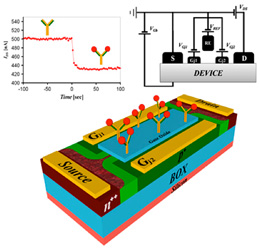静電的に形成されるナノワイヤー・バイオセンサーを用いた特異的な無標識フェムトモル・バイオマーカー検出
Specific and label-free femtomolar biomarker detection with an electrostatically formed nanowire biosensor
2013年3月1日 NPG Asia Materials 5, e3 (2013) doi:10.1038/am.2012.75
バイオセンサー: 静電的なワイヤーチャネル形成

テルアビブ大学(イスラエル)のYossi Rosenwaks率いる研究チームはこのたび、ナノワイヤー系無標識バイオセンサーを作製する簡便な方法を考案した。このタイプのバイオセンサーは、標的分子の存在を検出して電気信号に変換する機能を持つことから、最近、タンパク質やDNA、ウイルスといった生体物質への応用向けに関心を集めている。しかしながら、ナノワイヤー形成方法のうち、ボトムアップ式の方法はスケールアップが難しく、トップダウン式の方法は比較的複雑なプロセスが必要という問題がある。これに対し、今回研究チームが考案したバイオセンサーは、デバイス作製後に静電的に形成されるナノワイヤー状の伝導チャネルを囲むように構造化されている。長方形型のこのデバイスは、各辺に1つずつ合計4つのゲートが配置されており、これらのゲートによって空乏領域が形成され、この空乏領域間にチャネルができる仕組みになっている。生体分子は、チャネルのサイズや形状、位置に依存する感度で検出されるが、今回の実験では、フェムトモル濃度のタンパク質の存在を確認することに成功した。こうした複合的方法は、性能がよいだけでなく、標準的な集積回路加工技術でデバイスを形成できるため、リアルタイム診断用として非常に有望である。
Biosensors: Wires go electrostatic
A team of researchers from Israel, led by Yossi Rosenwaks at Tel Aviv University, has devised a facile route towards nanowire-based, label-free biosensors. These sensors have recently garnered interest for applications in biological species such as proteins, DNA or viruses: the presence of the target molecule is detected and converted into an electrical signal. But bottom-up strategies to prepare the nanowires are difficult to scale-up, while top-down approaches involve a relatively complex process. In contrast, the biosensor devised by Rosenwaks and co-workers is organized around a nanowire-like conducting channel that is formed electrostatically after device fabrication. The rectangular device comprises four gates at each extremity and these form depletion regions between which the channel is defined. Biomolecules are then detected with a sensitivity that depends on the size, shape and location of the channel — the presence of proteins was successfully determined at femtomolar concentrations. This combined approach brings together good performance with standard integrated circuit processing and holds great promise for real-time diagnostic applications.

